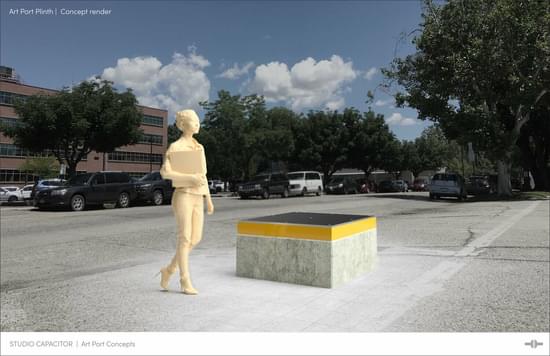




This new products proposes infrastructural necessities of public art be decoupled from the work, and instead be a part of the Active Transportation landscape. This manifests in flexible, reusable, foundational footings designed with temporary and permanent public art opportunities in mind.

Our cities are living, breathing extensions of our species, and as we evolve, so do the places we live. Our urban landscapes get smarter, cleaner, and more innovative as we do. We build living walls and digital wayfinding systems, we have scenic walkways that encourage green transport and we have more expansive public transportation. Our daily paths that move through and around the structures we build, continue to change as our cities change. Studio Capacitor believes these spaces of Active Transportation are where society truly sees itself, and as such are canvases worthy of both sharp critique and bold experimentation.
As our buildings stretch higher and roads creep wider, it is our responsibility to maintain the beauty and creativity essential to our humanity. This is where public art comes into play, evoking social commentary and beauty amongst our industrial structures. One of the largest hurdles for artists and cities alike, resides in the logistical aspects of a public art project. Often, public art projects require large chunks of time, money and effort to engineer the structural stability, and overall durability, in the foundational footing alone.
We propose that the infrastructural necessities of public art be decoupled from the work, and instead be a part of the Active Transportation landscape. This manifests in flexible, reusable foundational footings, designed with temporary and permanent public art opportunities in mind. By creating these Art Ports, it allows for more of the budget to be invested in the actual artwork itself, and allows for dynamic, revolving art programs.
By streamlining the public art process in this manner, it allows cities to invest in cultivating their art scene and the overall culture within urban places. This in turn enhances the livability and the experiences people have within that city.
The standardized format, materials and simple design allow for easy, low-cost assembly and reproduction. For more information about the design of the Art Port and how to use one in your city please visit https://www.studiocapacitor.co...
Testimonials:
Stephanie Inman
Treasure Valley based, national accredited public artist :
"I like it. Make it simple, make it mainstream. I can think of a bunch of places and organizations that would benefit from this, developers and artists."
Ken McCall
Treasure Valley based, national accredited public artist :
"The fact that the attachment system of the Art Port is simple, means that the City or a contractor, can easily install the work. This can be a huge cost savings for the artist, if they can simply ship the work to the location, and don't need to travel there themselves."
September 11th National Memorial Trail to Offer Interactive Map
posted Sep 11, 2021
The September 11th National Memorial Trail is a 1,300-mile system of trails and roadways that link the National September 11 Memorial and Museum in New York City, the National 9/11 Pentagon Memorial in Arlington, Virginia, and the Flight 93 National Memorial in Shanksville, Pennsylvania.
posted Nov 5, 2020
A presentation by Owen Worozbyt, Trail and Environmental Program Officer of the Lackawanna River Heritage Trail.
Santa Rosa Public Art Master Plan
posted Aug 18, 2020
The Plan describes what the Public Art Program’s priorities should be. The Public Art Program will catalyze new projects, provide guidance to projects undertaken by developers and others, and continue community outreach and education around public art.
Hank Aaron State Trail Art Concept Plan
posted Aug 18, 2020
The Friends of Hank Aaron State Trail commissioned this Art Concept Plan to lay the groundwork for the placement of public art along the Trail. This Plan identifies sites in which art could most effectively be placed, establishes principles for its placement, and explores how art can go beyond familiar conventions to reinforce the identity of the Trail and its surroundings.
1,694 views • posted 05/18/2021